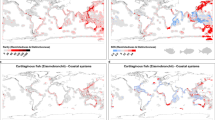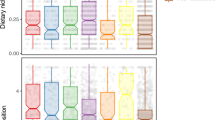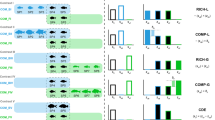Abstract
Species richness has dominated our view of global biodiversity patterns for centuries1,2. The dominance of this paradigm is reflected in the focus by ecologists and conservation managers on richness and associated occurrence-based measures for understanding drivers of broad-scale diversity patterns and as a biological basis for management3,4. However, this is changing rapidly, as it is now recognized that not only the number of species but the species present, their phenotypes and the number of individuals of each species are critical in determining the nature and strength of the relationships between species diversity and a range of ecological functions (such as biomass production and nutrient cycling)5. Integrating these measures should provide a more relevant representation of global biodiversity patterns in terms of ecological functions than that provided by simple species counts. Here we provide comparisons of a traditional global biodiversity distribution measure based on richness with metrics that incorporate species abundances and functional traits. We use data from standardized quantitative surveys of 2,473 marine reef fish species at 1,844 sites, spanning 133 degrees of latitude from all ocean basins, to identify new diversity hotspots in some temperate regions and the tropical eastern Pacific Ocean. These relate to high diversity of functional traits amongst individuals in the community (calculated using Rao’s Q6), and differ from previously reported patterns in functional diversity and richness for terrestrial animals, which emphasize species-rich tropical regions only7,8. There is a global trend for greater evenness in the number of individuals of each species, across the reef fish species observed at sites (‘community evenness’), at higher latitudes. This contributes to the distribution of functional diversity hotspots and contrasts with well-known latitudinal gradients in richness2,4. Our findings suggest that the contribution of species diversity to a range of ecosystem functions varies over large scales, and imply that in tropical regions, which have higher numbers of species, each species contributes proportionally less to community-level ecological processes on average than species in temperate regions. Metrics of ecological function usefully complement metrics of species diversity in conservation management, including when identifying planning priorities and when tracking changes to biodiversity values.
This is a preview of subscription content, access via your institution
Access options
Subscribe to this journal
Receive 51 print issues and online access
$199.00 per year
only $3.90 per issue
Buy this article
- Purchase on Springer Link
- Instant access to full article PDF
Prices may be subject to local taxes which are calculated during checkout


Similar content being viewed by others
References
Gaston, K. J. Global patterns in biodiversity. Nature 405, 220–227 (2000)
Hillebrand, H. On the generality of the latitudinal diversity gradient. Am. Nat. 163, 192–211 (2004)
Rodrigues, A. S. L. et al. Effectiveness of the global protected area network in representing species diversity. Nature 428, 640–643 (2004)
Wiens, J. J. & Donoghue, M. J. Historical biogeography, ecology and species richness. Trends Ecol. Evol. 19, 639–644 (2004)
Wittebolle, L. et al. Initial community evenness favours functionality under selective stress. Nature 458, 623–626 (2009)
Botta-Dukát, Z. Rao’s quadratic entropy as a measure of functional diversity based on multiple traits. J. Veg. Sci. 16, 533–540 (2005)
Safi, K. et al. Understanding global patterns of mammalian functional and phylogenetic diversity. Phil. Trans. R. Soc. B 366, 2536–2544 (2011)
Stevens, R. D., Cox, S. B., Strauss, R. E. & Willig, M. R. Patterns of functional diversity across an extensive environmental gradient: vertebrate consumers, hidden treatments and latitudinal trends. Ecol. Lett. 6, 1099–1108 (2003)
Luck, G. W. et al. Quantifying the contribution of organisms to the provision of ecosystem services. Bioscience 59, 223–235 (2009)
Cadotte, M. W. The new diversity: management gains through insights into the functional diversity of communities. J. Appl. Ecol. 48, 1067–1069 (2011)
Devictor, V. et al. Spatial mismatch and congruence between taxonomic, phylogenetic and functional diversity: the need for integrative conservation strategies in a changing world. Ecol. Lett. 13, 1030–1040 (2010)
Allen, G. R. Conservation hotspots of biodiversity and endemism for Indo-Pacific coral reef fishes. Aquatic Conserv. 18, 541–556 (2008)
Roberts, C. M. et al. Marine biodiversity hotspots and conservation priorities for tropical reefs. Science 295, 1280–1284 (2002)
Tittensor, D. P. et al. Global patterns and predictors of marine biodiversity across taxa. Nature 466, 1098–1101 (2010)
Grime, J. P. Benefits of plant diversity to ecosystems: immediate, filter and founder effects. J. Ecol. 86, 902–910 (1998)
Edgar, G. J., Banks, S., Fariña, J. M., Calvopiña, M. & Martínez, C. Regional biogeography of shallow reef fish and macro-invertebrate communities in the Galapagos archipelago. J. Biogeogr. 31, 1107–1124 (2004)
Duffy, J. E. Why biodiversity is important to the functioning of real-world ecosystems. Front. Ecol. Environ 7, 437–444 (2009)
Gamfeldt, L. et al. Higher levels of multiple ecosystem services are found in forests with more tree species. Nature Commun. 4, 1340 (2013)
Mora, C. et al. Global human footprint on the linkage between biodiversity and ecosystem functioning in reef fishes. PLoS Biol. 9, e1000606 (2011)
Fonseca, C. R. & Ganade, G. Species functional redundancy, random extinctions and the stability of ecosystems. J. Ecol. 89, 118–125 (2001)
Mouillot, D. et al. Rare species support vulnerable functions in high-diversity ecosystems. PLoS Biol. 11, e1001569 (2013)
Duffy, J. et al. Envisioning a marine biodiversity observation network. Bioscience 63, 350–361 (2013)
Wood, L. J., Fish, L., Laughren, J. & Pauly, D. Assessing progress towards global marine protection targets: shortfalls in information and action. Oryx 42, 340–351 (2008)
Pala, C. Giant marine reserves pose vast challenges. Science 339, 640–641 (2013)
Margules, C. R. & Pressey, R. L. Systematic conservation planning. Nature 405, 243–253 (2000)
Mouillot, D., Graham, N. A. J., Villéger, S., Mason, N. W. H. & Bellwood, D. R. A functional approach reveals community responses to disturbances. Trends Ecol. Evol. 28, 167–177 (2013)
Jones, J. P. G. et al. The why, what, and how of global biodiversity indicators beyond the 2010 target. Conserv. Biol. 25, 450–457 (2011)
Spalding, M. D. et al. Marine ecoregions of the world: a bioregionalization of coastal and shelf areas. Bioscience 57, 573–583 (2007)
Edgar, G. J. & Stuart-Smith, R. D. Ecological effects of marine protected areas on rocky reef communities: a continental-scale analysis. Mar. Ecol. Prog. Ser. 388, 51–62 (2009)
Jost, L. Entropy and diversity. Oikos 113, 363–375 (2006)
Edgar, G. J., Barrett, N. S. & Stuart-Smith, R. D. Exploited reefs protected from fishing transform over decades into conservation features otherwise absent from seascapes. Ecol. Appl. 19, 1967–1974 (2009)
Tuomisto, H. An updated consumer’s guide to evenness and related indices. Oikos 121, 1203–1218 (2012)
Laliberté, E. & Legendre, P. A distance-based framework for measuring functional diversity from multiple traits. Ecology 91, 299–305 (2010)
Laliberté, E. & Shipley, B. FD: measuring functional diversity from multiple traits, and other tools for functional ecology. R package version 1.0-11 (2011).
Edgar, G. J., Barrett, N. S. & Morton, A. J. Biases associated with the use of underwater visual census techniques to quantify the density and size-structure of fish populations. J. Exp. Mar. Biol. Ecol. 308, 269–290 (2004)
Breiman, L. Random forests. Mach. Learn. 45, 5–32 (2001)
Tyberghein, L. et al. Bio-ORACLE: a global environmental dataset for marine species distribution modelling. Glob. Ecol. Biogeogr. 21, 272–281 (2012)
Silverman, B. W. Density Estimation for Statistics and Data Analysis. (Chapman and Hall, 1986)
Strobl, C., Boulesteix, A.-L., Kneib, T., Augustin, T. & Zeileis, A. Conditional variable importance for random forests. BMC Bioinformatics 9, 307 (2008)
Ellis, N., Smith, S. & Pitcher, C. Gradient forests: calculating importance gradients on physical predictors. Ecology 93, 156–168 (2012)
Moran, P. A. P. Notes on continuous stochastic phenomena. Biometrika 37 17–23 10.2307/2332142 (1950)
Karpievitch, Y. V., Hill, E. G., Leclerc, A. P., Dabney, A. R. & Almeida, J. S. An introspective comparison of random forest-based classifiers for the analysis of cluster-correlated data by way of RF++. PLoS ONE 4, e7087 (2009)
Acknowledgements
We thank the many Reef Life Survey (RLS) divers who participated in data collection and provide ongoing expertize and commitment to the program, University of Tasmania staff including T. Cooper, M. Davey, N. Barrett, J. Berkhout and E. Oh, and T. Bird for assistance running models and checking code. Development of the RLS data set was supported by the former Commonwealth Environment Research Facilities Program, and analyses were supported by the Australian Research Council, Institute for Marine and Antarctic Studies, and the Marine Biodiversity Hub, a collaborative partnership supported through the Australian Government’s National Environmental Research Program. Additional funding and support for field surveys was provided by grants from the National Geographic Society, Conservation International, Wildlife Conservation Society Indonesia, The Winston Churchill Memorial Trust, and ASSEMBLE Marine.
Author information
Authors and Affiliations
Contributions
R.D.S.-S., J.S.L., G.J.E., S.C.B. and A.E.B. conceived the idea, G.J.E., R.D.S.-S., J.F.S.-S., S.C.B., S.J.K., G.A.S., E.M.A.S. and many others collected the data. R.D.S.-S., A.E.B., J.E.D., G.J.E., and J.S.L. drafted the paper, with substantial input from S.C.B., R.J.T., J.F.S.-S., N.A.H., S.J.K., L.A., M.A.B., S.J.C., T.P.D., S.A.N., G.A.S., E.M.A.S. and T.J.W. A.E.B., R.J.T. and J.S.L. analysed the data and S.J.K. prepared the maps.
Corresponding author
Ethics declarations
Competing interests
The authors declare no competing financial interests.
Extended data figures and tables
Extended Data Figure 1 Global relationships between different functional diversity measures.
a, b, Abundance-weighted functional diversity (Rao’s Q expressed as effective numbers; see Methods) for reef fishes provides different information to functional richness expressed as the number of functional groups (functional group richness; FGR) (a) and the volume of multidimensional trait space filled by the community (convex hull volume) (b). Kendall’s Tau correlation coefficients, r = 0.21 and 0.11, respectively. Points represent individual reef sites surveyed.
Extended Data Figure 2 Details of global fish surveys.
a, b, The fish fauna was quantitatively surveyed at 1,844 rocky and coral reef sites in 11 Marine Ecoregions of the World realms by visual census (a). Note that many sites are overlapping or hidden behind symbols for other sites. Tropical realms possessed much higher average fish abundance and species densities (b).
Extended Data Figure 3 The accuracy importance of the thirteen predictor variables for each of the random forest models.
Models were for species density (a), species evenness (b), functional group richness (c) and functional diversity (d). Explanations and units for variables are provided in Extended Data Table 4.
Extended Data Figure 4 Scatter plots comparing global predictions from random forest models used for mapping in Fig. 1 with those based on a training set including only sites >5 km apart.
Models were for species density (a), functional group richness (b), species evenness (c) and functional diversity (d). Predictions were compared for all global ocean grid cells where the depth was less than 20 m.
Supplementary information
Supplementary Information
This file contains Supplementary Text and additional references. (PDF 206 kb)
PowerPoint slides
Rights and permissions
About this article
Cite this article
Stuart-Smith, R., Bates, A., Lefcheck, J. et al. Integrating abundance and functional traits reveals new global hotspots of fish diversity. Nature 501, 539–542 (2013). https://doi.org/10.1038/nature12529
Received:
Accepted:
Published:
Issue Date:
DOI: https://doi.org/10.1038/nature12529
This article is cited by
-
The intestinal digesta microbiota of tropical marine fish is largely uncultured and distinct from surrounding water microbiota
npj Biofilms and Microbiomes (2024)
-
Marine protected areas promote stability of reef fish communities under climate warming
Nature Communications (2024)
-
Functional diversity of fish assemblages across a latitudinal gradient in coral ecosystems of the Mexican Tropical Pacific
Environmental Biology of Fishes (2024)
-
Fish functional diversity is modulated by small-scale habitat complexity in a temperate ecosystem
Hydrobiologia (2023)
-
Effects of habitat regime type on fish diversity in a large eutrophic lake
Hydrobiologia (2023)
Comments
By submitting a comment you agree to abide by our Terms and Community Guidelines. If you find something abusive or that does not comply with our terms or guidelines please flag it as inappropriate.



